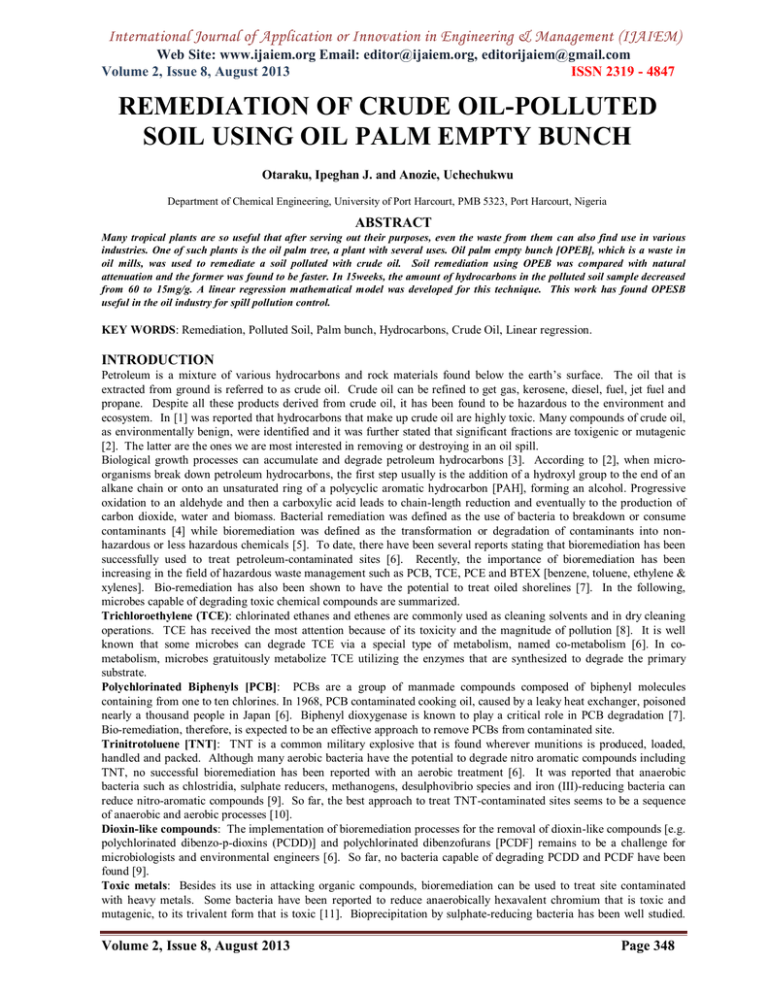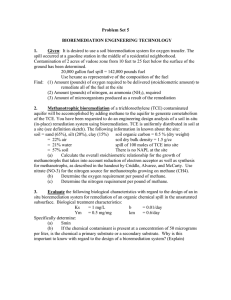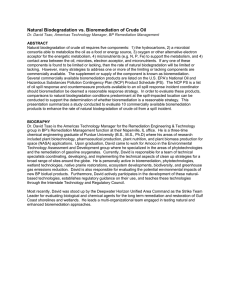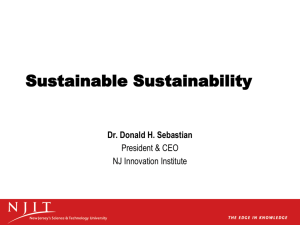International Journal of Application or Innovation in Engineering & Management... Web Site: www.ijaiem.org Email: , Volume 2, Issue 8, August 2013
advertisement

International Journal of Application or Innovation in Engineering & Management (IJAIEM) Web Site: www.ijaiem.org Email: editor@ijaiem.org, editorijaiem@gmail.com Volume 2, Issue 8, August 2013 ISSN 2319 - 4847 REMEDIATION OF CRUDE OIL-POLLUTED SOIL USING OIL PALM EMPTY BUNCH Otaraku, Ipeghan J. and Anozie, Uchechukwu Department of Chemical Engineering, University of Port Harcourt, PMB 5323, Port Harcourt, Nigeria ABSTRACT Many tropical plants are so useful that after serving out their purposes, even the waste from them can also find use in various industries. One of such plants is the oil palm tree, a plant with several uses. Oil palm empty bunch [OPEB], which is a waste in oil mills, was used to remediate a soil polluted with crude oil. Soil remediation using OPEB was compared with natural attenuation and the former was found to be faster. In 15weeks, the amount of hydrocarbons in the polluted soil sample decreased from 60 to 15mg/g. A linear regression mathematical model was developed for this technique. This work has found OPESB useful in the oil industry for spill pollution control. KEY WORDS: Remediation, Polluted Soil, Palm bunch, Hydrocarbons, Crude Oil, Linear regression. INTRODUCTION Petroleum is a mixture of various hydrocarbons and rock materials found below the earth’s surface. The oil that is extracted from ground is referred to as crude oil. Crude oil can be refined to get gas, kerosene, diesel, fuel, jet fuel and propane. Despite all these products derived from crude oil, it has been found to be hazardous to the environment and ecosystem. In [1] was reported that hydrocarbons that make up crude oil are highly toxic. Many compounds of crude oil, as environmentally benign, were identified and it was further stated that significant fractions are toxigenic or mutagenic [2]. The latter are the ones we are most interested in removing or destroying in an oil spill. Biological growth processes can accumulate and degrade petroleum hydrocarbons [3]. According to [2], when microorganisms break down petroleum hydrocarbons, the first step usually is the addition of a hydroxyl group to the end of an alkane chain or onto an unsaturated ring of a polycyclic aromatic hydrocarbon [PAH], forming an alcohol. Progressive oxidation to an aldehyde and then a carboxylic acid leads to chain-length reduction and eventually to the production of carbon dioxide, water and biomass. Bacterial remediation was defined as the use of bacteria to breakdown or consume contaminants [4] while bioremediation was defined as the transformation or degradation of contaminants into nonhazardous or less hazardous chemicals [5]. To date, there have been several reports stating that bioremediation has been successfully used to treat petroleum-contaminated sites [6]. Recently, the importance of bioremediation has been increasing in the field of hazardous waste management such as PCB, TCE, PCE and BTEX [benzene, toluene, ethylene & xylenes]. Bio-remediation has also been shown to have the potential to treat oiled shorelines [7]. In the following, microbes capable of degrading toxic chemical compounds are summarized. Trichloroethylene (TCE): chlorinated ethanes and ethenes are commonly used as cleaning solvents and in dry cleaning operations. TCE has received the most attention because of its toxicity and the magnitude of pollution [8]. It is well known that some microbes can degrade TCE via a special type of metabolism, named co-metabolism [6]. In cometabolism, microbes gratuitously metabolize TCE utilizing the enzymes that are synthesized to degrade the primary substrate. Polychlorinated Biphenyls [PCB]: PCBs are a group of manmade compounds composed of biphenyl molecules containing from one to ten chlorines. In 1968, PCB contaminated cooking oil, caused by a leaky heat exchanger, poisoned nearly a thousand people in Japan [6]. Biphenyl dioxygenase is known to play a critical role in PCB degradation [7]. Bio-remediation, therefore, is expected to be an effective approach to remove PCBs from contaminated site. Trinitrotoluene [TNT]: TNT is a common military explosive that is found wherever munitions is produced, loaded, handled and packed. Although many aerobic bacteria have the potential to degrade nitro aromatic compounds including TNT, no successful bioremediation has been reported with an aerobic treatment [6]. It was reported that anaerobic bacteria such as chlostridia, sulphate reducers, methanogens, desulphovibrio species and iron (III)-reducing bacteria can reduce nitro-aromatic compounds [9]. So far, the best approach to treat TNT-contaminated sites seems to be a sequence of anaerobic and aerobic processes [10]. Dioxin-like compounds: The implementation of bioremediation processes for the removal of dioxin-like compounds [e.g. polychlorinated dibenzo-p-dioxins (PCDD)] and polychlorinated dibenzofurans [PCDF] remains to be a challenge for microbiologists and environmental engineers [6]. So far, no bacteria capable of degrading PCDD and PCDF have been found [9]. Toxic metals: Besides its use in attacking organic compounds, bioremediation can be used to treat site contaminated with heavy metals. Some bacteria have been reported to reduce anaerobically hexavalent chromium that is toxic and mutagenic, to its trivalent form that is toxic [11]. Bioprecipitation by sulphate-reducing bacteria has been well studied. Volume 2, Issue 8, August 2013 Page 348 International Journal of Application or Innovation in Engineering & Management (IJAIEM) Web Site: www.ijaiem.org Email: editor@ijaiem.org, editorijaiem@gmail.com Volume 2, Issue 8, August 2013 ISSN 2319 - 4847 They convert sulphate in the groundwater to hydrogen sulphide which in turn reacts with heavy metals to form insoluble metal sulphide such as zinc sulphide and cadmium sulphide. Biomethylation to yield volatile derivatives such as dimethylselenide or trimethylarsine is a well-known phenomenon catalyzed by a variety of bacteria, algae and fungi [6]. Hydrocarbon-degrading microorganisms are ubiquitously distributed in soil and aquatic environments. Populations of hydro-carbon-degraders normally constitute less than 1% of the total microbial communities, but when oil pollutants are present, these hydrocarbons degrading populations increase, typically to 10% of the community [12]. Heartland microbes [a liquid culture of living microorganism capable of performing a variety of biodegrading tasks] that can utilize Benzene, toluene and xylene [BTX] were identified as source of food and energy [13]. As the fuel is broken down into smaller, simpler by-products by one group of microbes, other microbes in Heartland microbes are then able to complete the work of breaking it down completely to carbon dioxide and water in a process known as mineralization. Using Remediation by Enhanced Natural Attenuation [RENA] Technique, some scientists were able to stimulate Total Hydrocarbon Utilizing Bacteria [THUB] native in the contaminated soil and increase their growth from 85.0x104m3u/kg to 242.2x104m3u/kg [14]. This work showed that RENA technique could be employed to remediate a farm settlement contaminated by crude oil [14]. In this work, decayed Oil Palm Empty Bunch [OPEB] was selected as a remediating agent. OPEB has been found to be a source of very good organic fertilizer. To mills that process palm fruit, to extract oil, OPEB is 100% waste [NASH, 2013]. There is every need to devise means on how to make this material useful either by recycling or re-use. Studies have shown that every tonne of OPEB contains 18.0kg muriate of potash and Urea 3.8kg as well as 1 percentage composition of dry matter with nutrient content of nitrogen [N] 0.44, phosphorous [P] 0.144, potassium [K] 2.24, magnesium [Mg] 0.36, calcium [Ca] 0.36. All these materials are required by all crops including oil palm trees. This suggests that OPEB is environmentally friendly. MATERIALS AND METHODS MATERIALS 1. Decayed Oil Palm Empty Bunch [OPEB] 2. Crude oil 3. 500ml measuring cylinder 4. Two (2) square meters of land EXPERIMENTAL PROCEDURE This experiment was carried out at the Choba Campus of the University of Port Harcourt, Choba, Rivers State, Nigeria. The soil was sandy clay soil. Two (2) square meters piece of land was divided into one (1) square meter each. The two plots were labelled A and B respectively. A 15 centimeters wide and 10cm deep trench was dug to demarcate the two plots. Soil samples from the two plots were collected and analyzed for Total Hydrocarbon Content (THC). The two plots were polluted with 500ml each of crude oil. The decayed OPEB was meshed and 500g of OPEB was applied on Plot A. A do-nothing- approach was applied in PLOT B, so it can be said to be the control experiment. Soil samples from the two plots were taken weekly for fifteen weeks and analyzed for THC. All other weather conditions were remained the same. RESULTS AND DISCUSSION RESULTS The THC of the soil in the two plots obtained weekly for fifteen (15) weeks are shown in table 1 below Table 1 Total Hydrocarbon Content of the two plots. Volume 2, Issue 8, August 2013 Page 349 International Journal of Application or Innovation in Engineering & Management (IJAIEM) Web Site: www.ijaiem.org Email: editor@ijaiem.org, editorijaiem@gmail.com Volume 2, Issue 8, August 2013 ISSN 2319 - 4847 The data were further analyzed with linear regression, using LINEST software, in Table 2 below. Table 2 Data for Microbial remediation modelling Using the Linear Regression Model: DECAYED FLUTED WEEKS CONCENTRATION APPLIED IN g 1 60 500 2 45 0 3 43.5 0 4 43.5 0 5 41.5 0 6 40.5 0 7 37 0 8 35 0 9 31 0 10 29 0 11 26 0 12 22 0 13 21 0 14 18 0 15 15 0 36.99735 86.73218967 -1913.501251 6.693454 18.39062051 372.0792174 0.770869 66.74822126 #N/A 20.18589 12 #N/A 179869.4 53463.90049 #N/A #N/A #N/A #N/A #N/A #N/A #N/A #N/A #N/A #N/A #N/A #N/A #N/A Y = a0 + a1 X1 + a2 X2 (1) Where: Y = Amount of remediating agent needed for clean-up. X1 = time in weeks X2 = Concentration of pollutant after time, t. a0 and a1 = intercepts; a2 = slope. By substituting values in equation 1; the model below was derived. Y = -1913.5 + 86.7X1 + 37.0X2 (2) DISCUSSION: It was observed that the remediation rate of PLOT A became faster after weeks 3 and 4. This can be attributed to the further decay of the remediating agent, which is good organic manure that can create the enabling environment for microbes to thrive and multiply. PLOT B was observed to be much slower than PLOT A. The static THC observed in weeks 3 and 4 can be said to be a period of culturing microorganism for the remediation activity as this was not observed again throughout the research. CONCLUSION: 1. This work has shown that OPEB is a very effective remediating agent for crude oil-polluted soil. 2. OPEB can as well be used as an organic fertilizer. 3. The model developed can be used by operators in the oil industry for the remediation of crude oil in soil using OPEB. Volume 2, Issue 8, August 2013 Page 350 International Journal of Application or Innovation in Engineering & Management (IJAIEM) Web Site: www.ijaiem.org Email: editor@ijaiem.org, editorijaiem@gmail.com Volume 2, Issue 8, August 2013 ISSN 2319 - 4847 4. Waste agricultural products, like OPEB, can be harnessed for use in the Oil and Gas and allied industries. 5. Remediation period of crude oil-polluted soil can be shortened by introduction of OPEB. REFERENCES [1] Clark, B. [2012]: The Effects of oil in the Ecosystem. http://www.ehow.com [Accessed July 27, 2013]. [2] Venosa, D.V. [2012]: Bioremediation in Oil spill response www.NRTFSHEET.COM. [Accessed on July 27, 2013]. [3] Edema, C.U.; Idu, T.E. and Edema, M.O., [2010] Remediation of soil contaminated with polycyclic aromatic hydrocarbon from crude oil, African Journal of Biotechnology, Vol. 10(7); pp1146 – 1149. [4] Chamberlain, J: Bacterial Remediation, 2012, www.ehow.com/about 550977 bacterial remediation. [Accessed on July 27, 2013]. [5] Leung, M. [2004]: Bioremediation: Techniques for cleaning up a mess. www.bioteach.ubc.ca [Accessed on July 27, 2013]. [6] Tomatada, I. and Masao, N [2001]: Current Bioremediation practice and perspective; Journal of Bioscience and Bioengineering Vol. 92 [1] pp1-8. [7] Swannel, R.P.J; Mitchell, D. Lethbridge, G; Jones, D.; Health, D.; Hagley, M.; Jones, M.; Petch, S.; Milne, R.; Croxford, R. and Lee, K., [1999]: “A field Demonstration of the efficacy of Bioremediation to treat oiled shorelines following the sea Empress incident, Environmental Technology, Vol. 20, pp862. [8] Daniels, M.E. and Thomas, W.E.: A General Outline of Bioremediation, Indiana Department of Environmental Management, 2009. www.indem.IN.gov [Accessed on July 28, 2013]. [9] Spain, J.C. Biodegradation of Nitro-aromatic Compounds, Annual Review of Microbiology, 1995, Vol. 49 pp523– 555. [10] Dickel, O.; Hang, W. and Knackmuss, H.J.: Bioremediation of nitrobenzene by a sequential anaerobic-aerobic process. Biodegradation, 1993, Vol. 4 pp187 – 195. [11] Wang, P.; Mori, T.; Komori, K.; Sasatsu, M.; Toda, K. and Ohtake, H. [1989]: Isolation and characterization of an enterobacter Cloacae strain that reduces hexavalent chromium under anaerobic conditions. Appl. Environ. Microbial Vol. 55 1665 – 1669 [12] Atlas, R.M., [1995]: Bioremediation of Petroleum Pollutants “International Journal Remediation and Biodegradation, Vol. 5; PP317 – 327 [13] Hays, J.C. [2012]: Soil Remediation. www.heartlandmicrobes.com/soil remediation html. [14] Ebuehi, O.A.T.; Abibo, I.B.; Shekwolo, P.D.; Sigmund, K.I; Adoki, A and Okoro, I.C. [2005]: Remediation of crude oil contaminated soil by enhanced Natural Attenuation technique, Appl. Sc Environ.Mgt; Vol.9[1]:pp103-107. Volume 2, Issue 8, August 2013 Page 351




